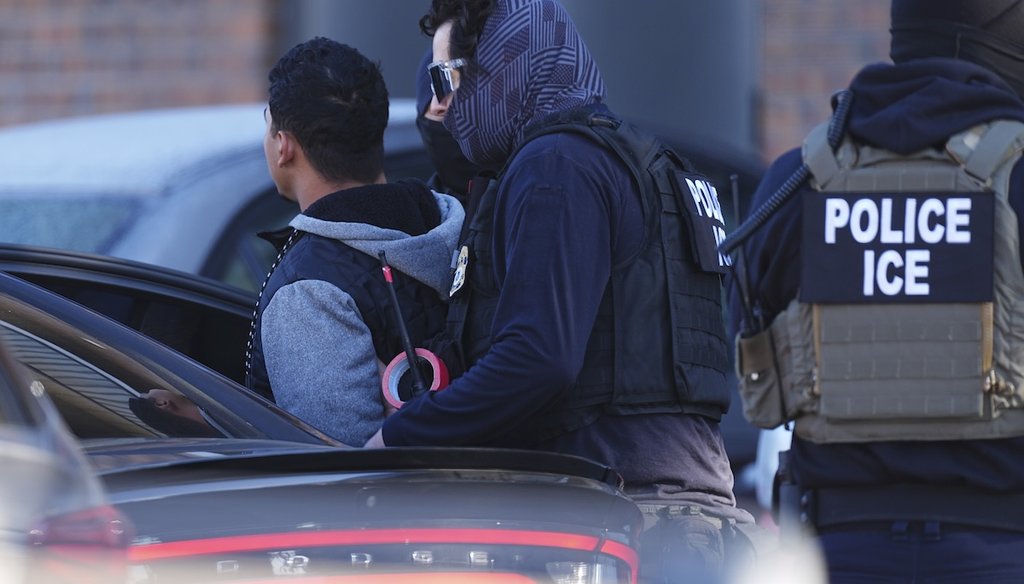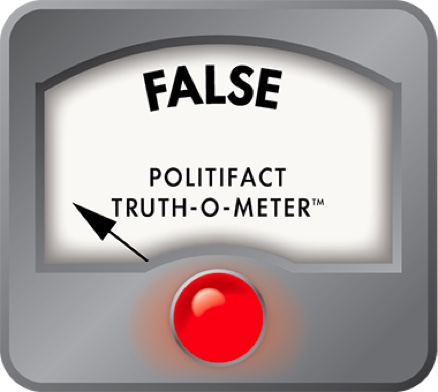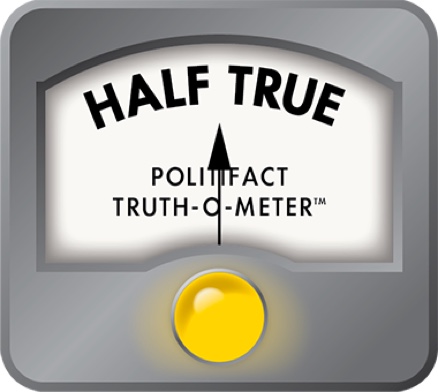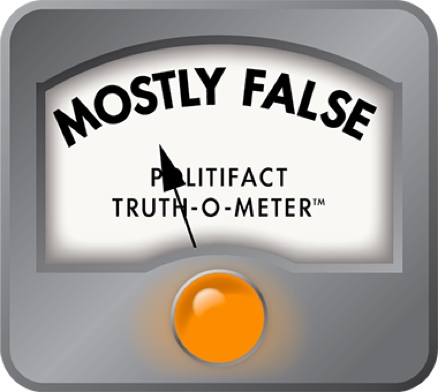Stand up for the facts!
Our only agenda is to publish the truth so you can be an informed participant in democracy.
We need your help.
I would like to contribute

Law officials load a man into a utility vehicle during a raid of an apartmeent complex, Feb. 5, 2025, in east Denver. (AP)
If Your Time is short
-
In just six weeks, President Donald Trump secured deportation agreements with other countries, started using Guántanamo Bay to detain migrants and expanded fast-track deportations.
-
He faces familiar challenges from similar deportation efforts in his first term, including limited funding for immigration enforcement.
In President Donald Trump’s first month back in office, the U.S. expanded old tactics and found new partners to help carry out his promised historic deportation efforts.
Phil McGraw, the former daytime TV host, brought cameras as agents arrested people in Chicago. Trump entered diplomatic deportation agreements with other countries so they take deported migrants. His administration sent migrants for detention at a U.S. military base in Guántanamo Bay and revoked an order limiting immigration agents from entering schools, churches and hospitals.
But there are obstacles in the way of Trump’s promise. High among them, money.
Without additional funds from Congress, Trump has limits on how many people he can arrest, detain and deport. Additionally, by ending programs that give some immigrants temporary legal status, he’s effectively increasing the number of people illegally in the country that his agents would need to find and deport.
Here’s an overview of Trump’s actions so far and what may complicate fulfilling this campaign promise.
Sign up for PolitiFact texts

Law officials enter an apartment complex during a raid Feb. 5, 2025, in east Denver. (AP)
Secured deportation agreements with foreign countries: Multiple countries including Panama, Costa Rica and El Salvador have agreed to accept people deported from the U.S. who are not from those countries. This lets the U.S. deport people who would otherwise be released into the U.S., because their countries don’t accept U.S. deportation flights.
Venezuela has also agreed to take back deportees; it had stopped accepting deportation flights during Trump’s first term, citing U.S. sanctions, and temporarily resumed them under Biden’s administration.
Expanded detention space: Congress has appropriated enough funding for Immigration and Customs Enforcement to detain about 40,000 people a day. Detention capacity was slightly above that limit, as of Feb. 27. Some people in detention were arrested during Biden's administration.
Trump started sending immigrants detained in the U.S. to Guantánamo Bay, the naval base best known as a high-security prison for foreign terrorism suspects following the Sept. 11, 2001, terrorist attacks. Several human rights organizations sued the government Feb. 12, saying immigrants sent to Guantánamo Bay did not have access to lawyers or to their families.
Reassigned personnel: Immigration and Customs Enforcement's Homeland Security Investigations unit generally investigates federal crimes, such as human trafficking and drug trafficking. But Trump signed an executive order requiring the office to focus on immigration violations.
Members of the Internal Revenue Service, U.S. Marshals Service, Drug Enforcement Agency and Bureau of Alcohol, Tobacco, Firearms and Explosives have also been asked to support immigration enforcement, a Feb. 27 report from the nonpartisan Migration Policy Institute said.
Expanded fast-track deportations: Trump expanded a fast-track deportation process that allows immigration agents to deport people without a court hearing.
Under the new policy, agents can deport people living in the U.S. who can't prove they've been in the U.S. for more than two years. Previously, agents used expedited removal only with people who were in the U.S. for less than two weeks and who were detained within 100 miles of a U.S. border.
Revoked sensitive locations ban: The Trump administration revoked an order that barred Immigration and Customs Enforcement agents from arresting people at schools, hospitals and religious buildings.
Terminated priorities for deportation policy: Trump ended a Biden-era policy that ordered immigration agents to prioritize arresting and deporting people who posed public safety or national security threats.
There’s no official publicly available data for how many people Trump has deported thus far. The Department of Homeland Security via two X posts late January and early February, said nearly 13,000 people were deported in Trump's first two weeks in office.

This photo provided by the U.S. Dept. of Defense, A U.S. Customs and Border Protection agent watches as immigrants illegally in the U.S. are loaded onto a C-17 Globemaster III at Tucson International Airport in Tucson, Ariz., Jan. 23, 2025. (AP)
Limited detention space: White House Press Secretary Karoline Leavitt said Feb. 5 that some people detained during the Trump administration's first few weeks were released. She attributed it to limited detention space, detainees’ serious medical conditions and an inability to quickly deport people. In 2001, the U.S. Supreme Court ruled that people cannot be indefinitely held in immigration detention.
Trump said he planned to detain 30,000 people in Guantánamo Bay. However, the base’s Migrant Operations Space was set up to hold about 130 people, according to the Global Detention Project, an international group that documents immigration detention worldwide. The Department of Defense ordered U.S. military members to set up tents to expand detention space.
Increased the population of people illegally in the U.S. by ending legal protections: Trump has ended several programs that allow people to live and work in the U.S. legally. These include Temporary Protected Status for Haitians and some Venezuelans, and humanitarian parole programs for people from certain countries who have U.S. sponsors. Without these protections, people can be subject to deportation. Many have to go through an immigration court case before being deported.
Fired immigration judges: The Trump administration fired 20 immigration judges on February 14, The Associated Press reported. More judges are needed to resolve pending immigration cases; there is a backlog of nearly 4 million.
Our Sources
ABC News, JD Vance says mass deportations should 'start with 1 million,' defends 'thought experiment' giving parents extra votes, Aug. 11, 2024
NBC News, 'Dr. Phil' embedded with immigration authorities during ICE action in Chicago, Jan. 27, 2025
U.S. Department of Homeland Security, X post, Jan. 27, 2025
U.S. Department of Homeland Security, X post, Feb. 4, 2025
The New York Times, Migrants, Deported to Panama Under Trump Plan, Detained in Remote Jungle Camp, Feb. 19, 2025
Facing pressure from Trump, Costa Rica and Honduras join Panama as stopovers for foreign deportees, Feb. 21, 2025
The Associated Press, Rubio says El Salvador offers to accept deportees from US of any nationality, including Americans, Feb. 4, 2025
The Associated Press, Venezuela sends 2 planes to US to return migrants, signaling a potential improvement in relations, Feb. 10, 2025
The New Times, Deportation Flights From the U.S. to Venezuela in Limbo, Feb. 7, 2024
American Immigration Council, The Cost of Immigration Enforcement and Border Security, August 2024
U.S. Immigration and Customs Enforcement, Detention Standards, Feb. 27, 2025
PolitiFact, US has held migrants at Guantánamo Bay before, but Trump’s approach is different, Feb. 9, 2025
U.S. Immigration and Customs Enforcement, Homeland Security Investigations, accessed March 3, 2025
The White House, Protecting the American people against invasion, Jan. 20, 2025
Migration Policy Institute, Trump Administration Bends U.S. Government in Extraordinary Ways towards Aim of Mass Deportations, Feb. 27, 2025
U.S. Department of Homeland Security, Designating Aliens for Expedited Removal, Jan. 24, 2025
The New York Times, Trump Expands Quick Deportations Across the U.S., Jan. 21, 2025
U.S. Department of Homeland Security, Statement from a DHS Spokesperson on Directives Expanding Law Enforcement and Ending the Abuse of Humanitarian Parole, Jan. 21, 2025
The White House, Press Secretary Karoline Leavitt Briefs Members of the Media, Feb. 5, 2025, Feb. 5, 2025
Global Detention Project, Guantanamo Migrant Operations Center, accessed March 3, 2025
The Associated Press, Justice Department fires 20 immigration judges from backlogged courts amid major government cuts, Feb. 15, 2025
Transactional Records Access Clearinghouse, Immigration, accessed March 3, 2025
Military.com, Marines, Soldiers Set Up Tents and Cots at Guantanamo Bay for Trump's Migrant Deportations, Feb. 3, 2025
U.S. Department of Defense, Building Tents, Feb. 9, 2025
U.S. Department of Defense, Email exchange, March 3, 2025




































